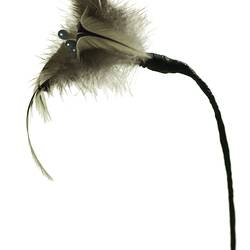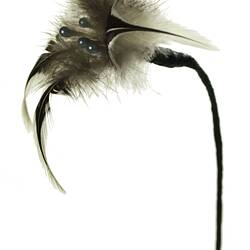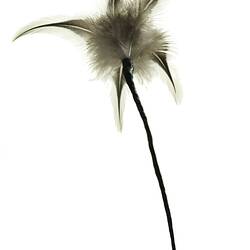Summary
One of eight children born to Letticia (Lettie) and Bevan Nicholls, and the granddaughter of Pastor Doug Nicholls, Janice Muir learnt the delicate craft of making feather flowers from her mother, a Ngarrindjeri woman from Bordertown in South Australia.
Struggling to make ends meet during the Depression era, Ngarrindjeri women would weave baskets and craft feather flowers to sell to visitors coming by steamer from Goolwa to Raukkan (Point McLeay). Feathers from birds such as the pelican, parrots, guineafowl and emu were collected and crafted into unique and beautiful flowers. These were used for a variety of ornamental and decorative purposes, including wedding bouquets, dress corsages and table centrepieces.
Ngarrindjeri Elder Aunty Edith Rigney (nee Kartinyeri), speaks of the importance of feather-flower making as a source of economic freedom, especially in mission times;
'We called her Mummy Fofon, or Aunty Fofon, and this is what my old Aunty Fofon and a lot of the old ladies taught me when I was a young woman. They taught me how to make feather flowers. We used to take them to the canteen. This was when the Salvation Army used to run the canteen on the mission at Raukkan, and whatever food we needed or anything, we exchanged it for the feather flowers. I bought a dinner set, my first little dinner set, through the canteen with feather flowers.' Aunty Edith Rigney, 1998.
Quote from Aunty Edith Rigney in 'Object summary' is from 'Ngarrindjeri Wurruwarrin: A World that Is, Was, and Will be By Diane Bell, 1998, pg 74.
Physical Description
Feather flower. Single. Five feathers, bound together at the base green tape. Stem made from metal wire wrapped in green tape. Centre of flower (stigma and style) made from wire wrapped in white tape with blue tips. Feathers black and white - white centre rib, black triangle, white edges.
Significance
The use of feathers for ornamentation is a significant cultural practice and this delicate flower made by Janice is a fine example of the skill and craft that has been handed down through the generations, particularly within the culture of the Ngarrindjeri nation of her mother.
Pioneering Australian feminist and anthropologist Diane Bell, who has worked extensively with Ngarrindjeri women for several decades, explains the multilayered cultural importance of feather-craft;
'Feather flowers and weaving keep people in touch with their world in tangible ways. Collection of material takes you out into the country with family. It forces you to look. The activities associated with weaving and feather flowers become the focus of sharing specialist knowledge about the country and its bounty.' Diane Bell, 1998
More Information
-
Object/Medium
Craft piece
-
Maker
-
Locality
-
Object Measurements
360 mm (Length), 100 mm (Width), 40 mm (Height)
-
Classification
-
Date Made
-
Maker
-
Clan/Language Group
-
Place Made
-
Indigenous Region
-
Keywords
-
Type of item
-
Discipline
-
Category
-
Collecting Areas




